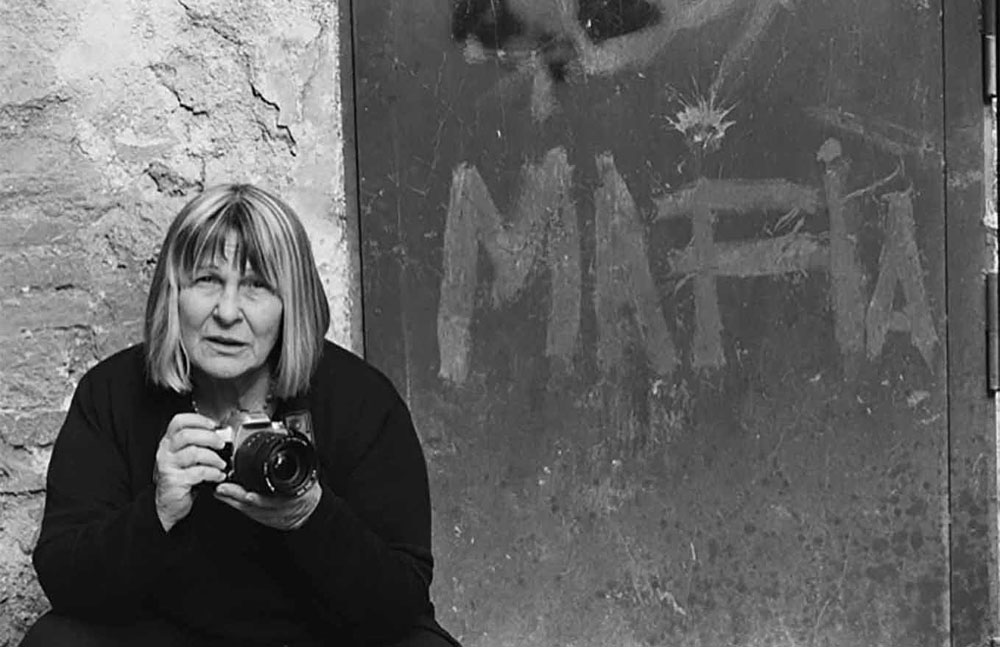Letizia Battaglia can distinctly remember the first murder scene she had to photograph, going so far as to recall the smell of olives in the air, though the memory becomes an anomaly in “Shooting the Mafia” since pain blinded her to many others. It’s why Kim Longinotto doesn’t take the tact most would in profiling a professional photographer, only occasionally showing the stark, inglorious pictures Battaglia has spent decades collecting of bloodied bodies of innocents massacred by the Mob in her home of Palermo, rarely lingering on them or asking how she snapped them. Instead, Longinotto asks what led her into such a thankless career, which has served as the opposite of a trap for Battaglia, liberated by defying the societal expectations set out for her as a woman.
“A flash of red hair, bobbing up and down at rallies,” as her assistant describes early in the film, Battaglia would be a fiery presence even without her mane to tip it off, speaking in a kind of blunt poetry as she smokes regally, bestowing a cinematic charisma to Longinotto’s portrait, even if the filmmaker is typically unfussy in her framing of her, at least visually. Long ago established as one of the most sophisticated storytellers at detailing the effects of a patriarchal culture and celebrating those who rise against it, Longinotto juxtaposes interviews with Battaglia against artifacts of larger Italian cultural currents of her time, whether it’s bold pop songs or clips from the passionate films of the era that clearly shaped her boisterous personality. Yet as they tell you one story, Battaglia tells another of being marginalized, first by her father who wouldn’t let her out of the house after a chance encounter with a pervert and then when she married at 16, unaware of any other options for her life.
“Her beauty provoked you,” says Edouardo, a colleague at L’Or, the newspaper Battaglia gravitated towards for work in her forties, ready to start a new life after her kids were raised, and although the compliment could suggest it wasn’t her eye that led others to embrace her professionally, Longinotto gently underscores how the photographer began to realize her power, both personally and professionally, as she discarded any ingrained notions of how she should behave that had been largely dictated by men. However, she also recognized how beguiling the image of the mafia had become in the public imagination and sought to take their power as well, muscling her way into crime scenes to deglamorize the violence that led so many to romanticize and accept it as part of Italian life.
Although “Shooting the Mafia” is less engaging when the focus shifts from Battaglia as a subject to having her dutifully recount how her own work as well as that of fearless prosecutors brought the top mobsters to justice, it’s a means to a most satisfying end as you come to realize while watching most of the mafia being put behind bars or going into hiding, that the girl who once was pent up by her father is now in charge of telling their story, deciding how they’ll go down in history. And as it becomes evident how lucky as we are to have Battaglia as a responsible steward and corrective to the mythology that gave strength to the mafia and kept them in power, she is equally fortunate to have Longinotto putting her story on the record.
“Shooting the Mafia” will screen at Sundance on January 26th at 6:30 pm at Redstone Cinema in Park City, January 27th at 9 pm at the Salt Lake City Library, January 30th at 3 pm at the Sundance Resort Screening Room, January 31st at 2:30 pm at the Prospector Square Theatre in Park City, and February 1st at 9 a.m. at the Temple Theatre in Park City.




